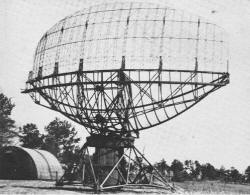|
Ryan Aeronautical Company was
founded in 1934, and became part of Teledyne in 1969, eventually being owned Northrop
Grumman in 1999. Ryan, which produced many airplanes and drones, was perhaps most
famous for building the
Spirit of
St. Louis (Ryan NYP) used by Charles Lindbergh on his historic transatlantic
flight. Ryan also dabbled in jet engines and electronics. The "packaged radar" concept
described in this 1952 Radio & Television News magazine article was the precursor to modular circuit assembly commonly
used in military systems to facilitate rapid field repair.
Packaged Radar
By William Wagner
Ryan Aeronautical Company

Using a jeweler's tool and magnifying glass, this Ryan electronics
engineer wires a packaged subminiature circuit used in the radar equipment developed
by Ryan.

Surrounded by a maze of intricate electronic test equipment,
this Ryan engineer checks an experimental circuit.

Radar, one of the greatest technical advancements of World War
II, utilizes huge parabolic scanners to transmit signals and receive echoes from
enemy aircraft in flight.
Flying radar stations for use in extremely advanced-type aircraft are being built
experimentally at Ryan Aeronautical Company in "packages" so small they could almost
fit into a briefcase or handbag.

An application in which the ultimate in telescoped radar installations
has been achieved. This is the Ryan "Firebird" - a fast air-to-air guided missile.

No larger than a package of cigarettes, this 5-tube miniature
radar amplifier has been compressed into unbelievably small proportions. (Right)

Viewed with a thumb tack and paper clip for comparison, this
miniature diode indicates the scale on which radar units are being built.
The flying radar station consists of an "intelligence" head, electronic circuitry,
and a power supply which provides the various voltages required. Tubes, resistors,
and coils no larger than a fingernail, a paper clip, or a key are packaged amidst
an intricate maze of wiring, some strands of which are as small as 3/1000th of an
inch. The cylinder housing the brain is likely to be less than a foot in diameter
and perhaps two feet long.
The "brain" contains the transmitter and receiver. The information reflected
back to the unit is received by a midget equivalent of the "dish" style antenna
of larger radar installations. The information thus received is channeled to two
locations - the "brain" to determine the navigation required, and the aircraft controls
for making the necessary flight adjustments.
The problems involved in producing such equipment include not only all of the
problems inherent in miniaturization but also problems encountered because of the
extremes of temperature at which the equipment is to operate and those which arise
because of the vibration and shock to which the gear is subjected.
The time-consuming and painstaking procedures necessary to develop this equipment
have been worked out satisfactorily and "packaged radar" is now a reality.
Posted April 29, 2022
(updated from original post on 11/15/2016)
|














